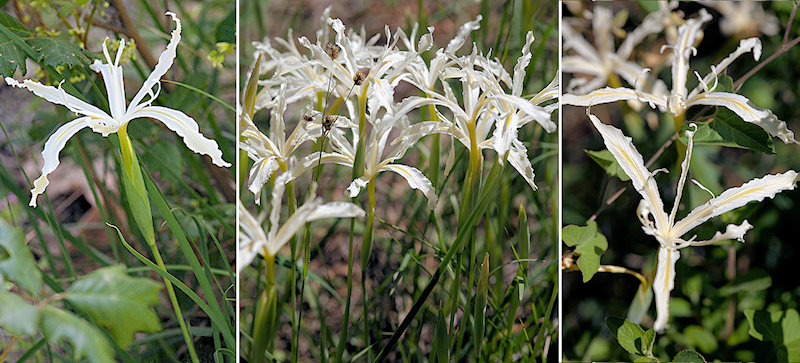Wild PCN iris - long tube group (5 species), spathes enclose ovary:
8. Shasta iris - Iris tenuissima

Iris tenuissima, near the type locality. Lakeside, Lake Shasta, Shasta County, CA. Tom Chism. May 13, 2010 (see the link below for additional photos).

Range: Northern California foothills around upper end of the Great Central Valley, southern Klamath and Cascade Ranges. From 300 to 6,000 feet elevation.
Original material: Pit River Ferry (today under the eastern arm of Lake Shasta), Shasta County, California 1912(?)
Key identifying features:
- Long floral tube; 1½ to 3 inches, tightly enclosed by spathes.
- Tube upper portion dilated, like the end of an upturned bottle.
- Long, narrow style crests, usually turned back inward.
- Petals and sepals slender and easily broken, their edges often wavy or ruffled.
- Flowers appear rather flat; petals and sepals spread outward.
- Stigma triangular, nearly tongue-shaped.
Flower color: White, cream, pale yellow to golden yellow (the latter perhaps through contact with Iris hartwegii), often with darker reddish-brown, lavender or yellow veins; flower tube yellow-green.
Habitat: Shaded, duff-covered forest floor or small sunny openings in oak/pine woodlands.
Name: By William Rickatson Dykes, for his specimens' markedly slender flower parts (tenuissima = very tenuous).
Comments: The Shasta Iris seems to replace Iris macrosiphon around the northern end of California's Great Central Valley. Flowers with long style crests and slender, easily broken parts with wavy edges help identify Iris tenuissima, though some flowers have exceedingly narrow parts and others less so.
One name sometimes used for this species - "long-tube iris" - might be more confusing than helpful. Four other Pacifica iris have floral, or perianth tubes as long or longer than those of Iris tenuissima.
Genetic studies confirm that Iris tenuissima and Iris chrysophylla are very close relatives. Their actual relationship and relative distribution in northern California cry out for further study. For years, enthusiasts have used a functional, but less than satisfying device - which we follow here - to separate those growing north of the Siskiyou mountains in Oregon (as I. chrysophylla); from those found south of the Siskiyous in California (as I. tenuissima).
Other features looked at include the floral tube (the diameter abruptly enlarged through most of the upper portion in tenuissima, uniform diameter throughout in chrysophylla), the stigma (sometimes finely toothed in tenuissima, entire in chrysophylla), and the flower stem (generally longer than 4 inches in tenuissima, often shorter than 4 in chrysophylla).
Iris tenuissima purdyiformis, an unusual population
Here is a clear example of how carelessly used labels can cause others serious confusion, unless we keep in mind the difference between a variety and a subspecies. "Variety" is an informal term (like "strain" or "form"), used to recognize that plants are seldom exactly identical. Even within a species, they can come in a wide range of size, form and color. Horticulturalists often seek
out particular varieties they especially like to propagate.
Robert Foster noticed that three of his Shasta iris specimens had bract-like leaves wrapping their their stem – something more often seen in Iris purdyi, or Iris bracteata. So he called the variety “purdyi-like” (purdyi + formis). Unfortunately, in giving them a name he used the Latinized three-part format preferably reserved when formally describing a subspecies.
Biologists have a strict understanding of the word “subspecies”. Within the entire range of a species, sometimes there are certain local populations that - because of their own slightly different history – have an unusual appearance or genetic makeup compared to the others.
Once those plants and the ways they differ from all the other populations are well enough understood, a researcher might designate them as a sub-species, and assign them a three-word Latinized name. The first is the name of the genus, the second of the species, and the third word is that population's own, unique label. But note - When the third and second names are the same, it simply refers back to the original species - it should not be misinterpreted as implying that all the remaining populations make up a unique separate sub-species.
Dr. Lee Lenz found that the Shasta iris growing along the Feather River canyon near Tobin on highway 70 had bract-like leaves enclosing most of the stem. He eventually designated those populations as representing a unique subspecies, and assigned them their formal name – Iris tenuissima purdyiformis.
Occasional specimens labeled "I. tenuissima purdyifomis" from other regions are deposited in several museums. We need to keep in mind that Lenz's word purdyiformis is not a descriptive term used to label any specimen of Shasta iris with bract-like leaves along its stem. It's a unique name - a name he applied only to plants of a specific population living a little ways east of Paradise in the northern Sierra Nevadas.
Additional Photos and Comments:
- Iris tenuissima at Lake Shasta, Shasta County
- I. tenuissima in Lassen, Shasta, and Trinity counties
- Iris tenuissima along the Klamath River, northern Trinity County
- Iris tenuissima on the the Salmon River, Siskiyou County
- Iris tenuissima purdyiformis growing in the Feather River Canyon in Plumas County
- Butterfly Valley Botanical Area